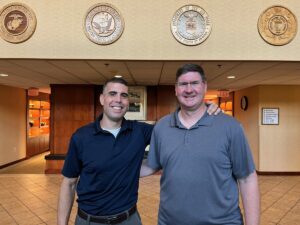
ALEXANDRIA, La. (BP)–It happened several years back, but he still remembers the day. And why not? It was a really bad day.
But that is not the part he remembers most. The part he remembers is walking the downtown streets of his adopted city, trying to figure out what he needed to do.
His walk brought him by the First Baptist Church of the city, an impressive, inviting structure located on the “main drag.”
He thought to go in, to find a place where he could sit and think — and pray.
He tried the front door, then the side door, then whatever door he could find.
Nothing.
All were locked.
Much is made these days about making a church accessible, visible. A lot of attention is paid to — and for — advertising.
Do people know where your church is? Can they find it easily? Is it well-located? While location, location, location is well and good, a new study suggests churches also should consider something more basic — most notably, is anyone home?
In other words, once people find your church or come across its advertisement in the phone book, will they be able to find someone there to help them?
Surely, they will, one supposes.
In this day and age of telephones and cell phones, answering machines and voice mails, e-mails and pagers, how could anyone ever be out of contact?
Suppose again.
Indeed, when a study was made of almost 4,000 churches, calls to 40 percent of them went unanswered by a live person, even when the calls were made repeatedly.
In other words, contact was made in some way at only 60 percent of churches. And that number was reached in the study only after researchers made as many as 12 calls to the churches — each on different days and at different times.
It gets worse.
After all, even if a live person did not answer, one would assume that some sort of contact could be established by leaving a voice mail or answering machine message.
However, in 44 percent of the churches where a live person did not answer, there was not even an answering machine to record a message.
In other words, somebody knocked — and nobody answered.
Wait, it gets even worse than that.
It takes an average of 2.1 telephone calls to reach a human being at a Protestant church during regular weekday business hours, a Barna Research Group study shows.
In the study, calls to only one-third of the churches were answered on the first attempt. In 10 percent of the churches eventually reached, it took at least four calls to make contact with a person.
Evangelical churches fared a little better — a person answered the phone 66 percent of the time for them.
Numbers varied among different denominations. For instance, nondenominational evangelical churches ranked high in the study — with 80 percent of calls answered by a live person. In turn, black churches had the lowest responsiveness.
Charismatic and Pentecostal churches were below average as well — a person answered the phone there just 53 percent of the time. However, independent fundamentalist churches rated high — their response rate was 81 percent.
Southern Baptists came in higher than the 56 percent average. A person answered the phone at 66 percent of Southern Baptist churches included in the study.
At the same time, United Methodist, Evangelical Lutheran, Presbyterian Church U.S.A. and Episcopal churches all recorded even higher percentages.
Church size makes a difference, the Barna study indicates. Simply put, the larger a church, the more likely it is that a person will answer a call — and on the first try. Indeed, in churches with 250 or more adults members, 70 percent of calls were answered by a live person on the first try. In churches with less than 100 adult members, that number drops to 44 percent.
“These statistics shed light on a challenge for churches that hope to connect with their surrounding communities,” noted George Barna, founder and president of the California-based research firm that conducted the study. “The exact statistics by denomination or church size are less important than the overall revelation about the inaccessibility of churches.
“In a world where people are extremely busy and are suspicious of the practical value of churches, they are not likely to make three or four calls to a church before they get to speak to a human being.”
Churches that influence communities do so through connections and relationships, Barna noted in a website report on the study. “The ability to communicate both personally and on-demand is crucial to fostering trust and continuity in a relationship,” he maintained.
“If churches really want to help people, they have to be accessible. When we make it difficult for people to get our attention, we send a negative message about the heart of the church while also training them to look elsewhere during their times of need.”
Creative options are available for churches that find it difficult to have a person on site to answer calls, Barna noted. He cited some churches that have calls forwarded to homes of members who have agreed to answer them for the day.
Answering machines are available as well — and relatively inexpensive.
Voice mail is an option also.
“There are many creative and inexpensive ways for churches that are presently inaccessible to make connections easier for everyone,” Barna insisted.
Finding no one home at the church, the man struggling with his day began to retrace his steps. The wind was colder as the day grew later.
In a bit, as he walked, he heard laughter.
Pausing, he saw an open door across the street. Inside, people were laughing. One could hear music — and almost feel the warmth from the room as it swarmed out the door into the chilly afternoon.
The place looked inviting.
He actually thought about crossing the street. And then he thought of the irony of the situation — the church closed but the local bar open and welcoming.
He began to walk again.
Maybe he could call the church when he got home and talk to someone that way.
Maybe he would get an answer.
Maybe not.
Maybe he would call a second time.
Maybe not.
Who can tell?
And unless someone finally answered the call, who would ever know?
–30–
Information on church-related studies by the Barna Research Group may be found on the Internet at www.barna.org.














